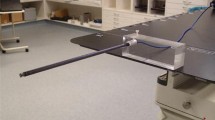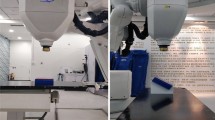Abstract
Chinese hamster ovary (CHO) cells and thermoluminescent detectors (TLD-700) were used for physical and biological verification of heavy ion treatment planning. Experiments were performed in a cylindrical water phantom, in some cases with lung and bone equivalent material in front of the target volume. The results confirm the possibility of using thermoluminescent detectors for a quantitative verification of dose distributions. CHO cells can be used at least for qualitative dose verification.
Similar content being viewed by others
Author information
Authors and Affiliations
Additional information
Received: 15 December 1997 / Accepted in revised form: 6 February 1998
Rights and permissions
About this article
Cite this article
Mitaroff, A., Kraft-Weyrather, W., Geiß, O. et al. Biological verification of heavy ion treatment planning. Radiat Environ Biophys 37, 47–51 (1998). https://doi.org/10.1007/s004110050091
Issue Date:
DOI: https://doi.org/10.1007/s004110050091




